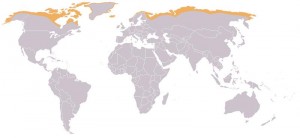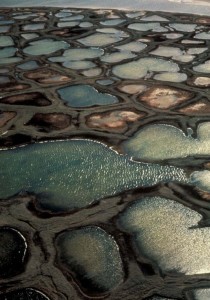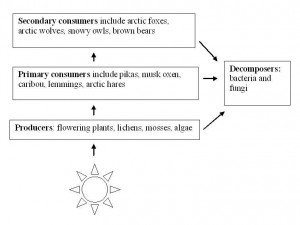What Animals Live in the Arctic Biome
TUNDRA
The tundra is a biome characterized by an extremely cold climate, little precipitation, poor nutrients, and a brusk growing flavour. Other characteristics include depression biodiversity, elementary plants, limited drainage, and big variations in populations.
There are two types of tundra: arctic and alpine. Chill tundra is located in the Northern Hemisphere; tall tundra is located at high elevations on mountains throughout the globe. Tundra is also found to a limited extent in Antarctica – specifically, the Antarctic Peninsula.
ARCTIC TUNDRA
Arctic tundra is found forth the northern coasts of North America, Asia, and Europe, and in parts of Greenland. It extends southward to the border of the taiga (a biome characterized by coniferous forests). The sectionalisation between the forested taiga and the treeless tundra is known every bit the timberline or tree line.
The tundra is known for common cold conditions, with an average winter temperature of -30 degrees F (-34 degrees C), and an average summertime temperature ranging from 37 degrees to 54 degrees F (three degrees to 12 degrees C). The growing flavor lasts from 50 to 60 days. The biome is too characterized past desertlike atmospheric condition, with an boilerplate of six to x inches (fifteen to 25 cm) of yearly precipitation, including snow melt. Winds ofttimes reach speeds of 30 to lx miles (48 to 97 km) an hour.
Another hallmark of the tundra is permafrost, a layer of permanently frozen subsoil and partially decayed organic thing. Just the top nine or 10 inches of soil thaw, leading to the germination of bogs and ponds each leap.
Water ice wedges in the permafrost can fissure and cause the formation of polygonal ground. This picture also illustrates the formation of ponds as the snow melts each spring. Photo courtesy of U.Due south. Fish and Wildlife Service.
Tundra and taiga permafrost stores virtually one-tertiary of the globe's soil-jump carbon. Warming Chill temperatures due to climate change are causing the permafrost to thaw, releasing the carbon in the form of carbon dioxide (a greenhouse gas). Additional carbon dioxide in the temper will intensify warming, leading to increased thawing and the release of even more carbon dioxide. This positive feedback loop thus has the potential to significantly increase the rate and effects of climate change.
Approximately 1,700 species of vascular plants are found across the Arctic tundra, including flowering plants, depression shrubs, sedges, grasses, and liverworts. Lichens, mosses, and algae are also common. In general, tundra plants are low growing, have shallow root systems, and are capable of carrying out photosynthesis at low temperatures and with low light intensities.
Animals found in the Chill tundra include herbivorous mammals (lemmings, voles, caribou, arctic hares, and squirrels), carnivorous mammals (arctic foxes, wolves, and polar bears), fish (cod, flatfish, salmon, and trout), insects (mosquitoes, flies, moths, grasshoppers, and blackflies), and birds (ravens, snowfall buntings, falcons, loons, sandpipers, terns, and gulls). Reptiles and amphibians are absent because of the extremely cold temperatures. While many of the mammals accept adaptations that enable them to survive the long cold winters and to breed and raise young apace during the brusk summers, most birds and some mammals migrate s during the winter. Migration means that Arctic populations are in continual flux.
A generalized nutrient web for the Chill tundra begins with the various plant species (producers). Herbivores (primary consumers) such equally pikas, musk oxen, caribou, lemmings, and arctic hares make up the next rung. Omnivores and carnivores (secondary consumers) such as arctic foxes, brown bears, arctic wolves, and snowy owls superlative the web. Bacteria and fungi play the important role of breaking down organic matter and returning nutrients to the soil for re-utilise. Of class, the exact species involved in this web vary depending on the geographic location.
The interconnected nature of a nutrient web means that equally numbers of one species increase (or decrease), other populations change in response. An oftentimes-discussed tundra example is the lemming population. Lemmings are small-scale rodents that feed on plants. Populations of lemmings fluctuate radically (from large populations to near extinction) in regular intervals. While scientists believed that populations of lemming predators (foxes, owls, skuas, and stoats) as well fluctuated in response to these changes, there is now bear witness that suggests that the predators themselves drive the changes in lemming populations.
Climate change is affecting tundra ecosystems in many ways. Thawing permafrost not only releases carbon dioxide but too leads to littoral erosion– an increasing problem in Alaska where villages are at risk. Warming also ways that seasons are arriving earlier – a shift not only in temperatures but likewise in the emergence and flowering of plants. Biologists suspect that a mismatch between found availability and calving is increasing mortality rates of caribou calves. Finally, species distributions may change as birds and other animals shift their range or migration patterns in response to irresolute temperatures.
ANTARCTIC TUNDRA
Much less all-encompassing than Arctic tundra, Antarctic tundra is institute on the Antarctic Peninsula and several Antarctic and subantarctic islands. These areas have rocky soil that supports minimal constitute life: 2 flowering found species, mosses, algae, and lichens. Antarctic tundra does non support mammals, but marine mammals and birds inhabit areas near the coast. All species in Antarctica and the Antarctic Islands (south of sixty degrees S breadth) are protected by the Antarctic Treaty.
LINKS
The World's Biomes
An overview of biomes and information on vi major types: freshwater, marine, desert, forest, grassland, and tundra.
Biomes and Ecosystems
General information virtually biomes and ecosystems, with links to pages about tundra, taiga, temperate forest, tropical rainforest, desert, grassland, and bounding main biomes. This site may also be used with upper-elementary students.
Geography4Kids: Biosphere
Includes pages on ecology, ecosystems, food chains, populations, and land biomes. Appropriate for utilise with upper-elementary students.
NATIONAL Scientific discipline EDUCATION STANDARDS: SCIENCE CONTENT STANDARDS
The entire National Science Education Standards document can be read online or downloaded for costless from the National Academies Press spider web site. The following extract was taken from Chapter 6.
Teaching virtually biomes (including the tundra) tin can come across a wide variety of fundamental concepts and principles, including:
K-iv Life Scientific discipline
The Characteristics of Organisms
- Organisms accept basic needs. For instance, animals need air, h2o, and nutrient; plants require air, water, nutrients, and light. Organisms can survive simply in environments in which their needs tin be met. The world has many different environments, and distinct environments support the life of different types of organisms.
Organisms and their Environments
- All animals depend on plants. Some animals eat plants for food. Other animals swallow animals that eat the plants.
- An organism's patterns of behavior are related to the nature of that organism's surround, including the kinds and numbers of other organisms present, the availability of nutrient and resources, and the physical characteristics of the environment. When the environs changes, some plants and animals survive and reproduce, and others die or move to new locations.
- All organisms cause changes in the surroundings in which they live. Some of these changes are detrimental to the organism or other organisms, whereas others are benign.
- Humans depend on their natural and constructed environments. Humans modify environments in ways that can be either beneficial or detrimental for themselves and other organisms.
One thousand-4 Scientific discipline in Personal and Social Perspectives
Changes in Environments
- Environments are the space, conditions, and factors that touch an individual'due south and a population'due south power to survive and their quality of life.
- Changes in environments can be natural or influenced past humans. Some changes are good, some are bad, and some are neither skilful nor bad. Pollution is a change in the environment that can influence the wellness, survival, or activities of organisms, including humans.
- Some environmental changes occur slowly, and others occur rapidly. Students should understand the different consequences of changing environments in small increments over long periods as compared with changing environments in large increments over short periods.
5-viii Life Science
Populations and Ecosystems
- A population consists of all individuals of a species that occur together at a given place and fourth dimension. All populations living together and the physical factors with which they interact compose an ecosystem.
- Populations of organisms tin be categorized past the office they serve in an ecosystem. Plants and some microorganisms are producers – they make their ain food. All animals, including humans, are consumers, which obtain food by eating other organisms. Decomposers, primarily leaner and fungi, are consumers that use waste materials and dead organisms for food. Food webs identify the relationships among producers, consumers, and decomposers in an ecosystem.
- For ecosystems, the major source of free energy is sunlight. Free energy entering ecosystems equally sunlight is transferred by producers into chemical free energy through photosynthesis. That energy then passes from organism to organism in nutrient webs.
- The number of organisms an ecosystem can support depends on the resources available and abiotic factors, such as quantity of calorie-free and water, range of temperatures, and soil composition. Given adequate biotic and abiotic resources and no disease or predators, populations (including humans) increase at rapid rates. Lack of resources and other factors, such as predation and climate, limit the growth of populations in specific niches in the ecosystem.
five-8 Science in Personal and Social Perspectives
Populations, Resources, and Environments
- When an area becomes overpopulated, the environs will get degraded due to the increased utilise of resources.
- Causes of ecology degradation and resources depletion vary from region to region and from country to land.
Natural Hazards
- Internal and external processes of the earth system cause natural hazards, events that alter or destroy human and wildlife habitats, damage holding, and damage or kill humans. Natural hazards include earthquakes, landslides, wildfires, volcanic eruptions, floods, storms, and fifty-fifty possible impacts of asteroids.
- Man activities also can induce hazards through resources acquisition, urban growth, land-use decisions, and waste disposal. Such activities tin accelerate many natural changes.
This commodity was written by Jessica Fries-Gaither. For more than information, see the Contributors folio. Email Kimberly Lightle, Chief Investigator, with any questions well-nigh the content of this site.
Copyright March 2009 – The Ohio State University. This material is based upon work supported by the National Science Foundation nether Grant No. 0733024. Any opinions, findings, and conclusions or recommendations expressed in this fabric are those of the author(due south) and practice not necessarily reverberate the views of the National Science Foundation. This piece of work is licensed under an Attribution-ShareAlike 3.0 Unported Creative Commons license .
What Animals Live in the Arctic Biome
Source: https://beyondpenguins.ehe.osu.edu/issue/tundra-life-in-the-polar-extremes/life-in-the-tundra





Comments
Post a Comment